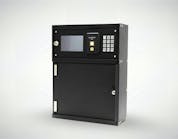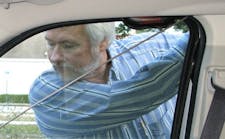The Bianchi 884 Decryptor Ultegra standalone, integrated transponder cloning device is capable of identifying and cloning more than 400 transponder-based engine immobilizer (anti-theft) system equipped vehicle models. The 884 Decryptor Ultegra does not require a computer, Internet connection or an attachment to clone any automotive transponder.
The 884 Decryptor Ultegra can clone vehicle transponders manufactured by Megamos, Philips, Temic and Texas Instruments using the Bianchi TK24, TK40 and TK60 electronic key heads. Note: These three Bianchi electronic heads can be cloned more than once to the same or different vehicle models. The Bianchi TK24 can be used to clone a number of fixed value transponders. The TK40 is designed for the Texas Instruments Encrypted transponder, and the TK60 is designed for the Philips® Crypto second generation 46 transponders. The Decryptor Ultegra is designed to follow the correct programming procedure for each of the three different electronic key heads. The cloning device identifies the transponder when the customer’s first key is inserted and read. To clone the transponder, just follow the instructions on the two-line, 20-character Liquid Crystal Display (LCD). Cloning the newly introduced Philips Crypto 46 transponders does require access to the vehicle in order to obtain the portion of the transponder chip value that is contained in the vehicle’s on-board computer system. To simplify the procedure, Bianchi offers an optional 12VDC cigarette lighter plug-in power cable for the 884 Decryptor Ultegra cloning device to clone these transponder-equipped keys at the vehicle. The cigarette lighter plug-in power cable can be used only if the lighter is constantly powered. For this article, we will clone Philips Crypto second generation 46 transponder equipped key for a 2009 Jeep Compass using the Bianchi 884 Decryptor Ultegra. The Bianchi full key is the BY165-PT RWP. This key blank is comprised of a TK60 electronic chip and the BY160U blade. The BTK60 electronic chip is a battery-less circuit board designed to mimic a Philips Crypto second generation 46 transponder chip. The electronics within the key head are “potted” to prevent moisture from contacting the circuitry.The BY160U horseshoe blade is the 8-cut blade currently being used on Chrysler, Dodge and Jeep vehicles that was introduced for the 1994 model year. The two components are designed to be snapped together, making a complete key. However, disassembling the two halves is not easy, requiring both tabs to be depressed at the same time and the head separated from the horseshoe blade.When Bianchi 884 Decryptor Ultegra is powered on, the LCD displays the KL logo and then the Decryptor Ultegra # 884 Release (firmware) Number. For this unit, the release number is 01.03e. The next display reads: INSERT THE KEY AND PRESS READ To clone one of the remote head keys for the 2009 Jeep Compass, place the remote head key into the Antenna Ring/Transponder Reader and press the READ (open book) button. Since this vehicle’s keys are equipped with a Philips Crypto transponder chip, the LCD displays: PHILIPS CRYPTO PH20 PRESS WRITE. The original key remains in the reader and press the WRITE (pencil) button. The LCD displays: INSERT TK60. PRESS WRITE. Remove the owner’s key and place a TK60 head into the 884 reader. Press the WRITE button. <The LCD displays: TK60 STEP 1 COMPLETE, PROCEED TO STEP 2. At this time, decode the owner’s key bittings and originate the cuts onto a BY160U horseshoe blade. Place the TK60 head onto the blade. It is recommended to not snap the two components together at this time. Next, insert the TK60 with the horseshoe blade into the ignition lock. Turn the ignition to the “On” position for 5 seconds, then quickly turn to the “Locked” position, and remove the key from the ignition for 2 seconds. Repeat this procedure 2 more times. The LCD displays: INSERT THE KEY AND PRESS READ. Insert the TK60 head and the blade into the reader and press the READ button. The LCD displays: STEP 2 READ COMPLETE. PRESS WRITE. Press the WRITE button. The LCD displays: PROG. CRYPTO KEY? RD=NO WR=YES Press WRITE to indicate YES. The LCD displays: INSERT ORIGINAL KEY PRESS WRITE Remove the TK60 with the horseshoe blade and insert the original key and press the WRITE button. There is no data being written to the original key’s transponder; however, data is being processed in order to complete the necessary value for the TK60 to be capable of completely communicating with the vehicle’s on-board computer.During this time, the LCD displays: CALCULATING . . . PLEASE WAIT 01 The number in the right bottom corner increases during the calculations. For this cloning procedure, the number increased to 43. After the calculations are complete, the LCD displays: RE-INSERT TK60 PRESS WRITE Remove the original key and insert the TK60 with the horseshoe blade and press the WRITE button.Wait until the LCD displays: WRITING SUCCESSFUL PRESS READ/WRITE
Remove the TK60 with the horseshoe blade “to be inserted” and use it to start the engine and let it idle. If the cloning is correct, the engine will start and continue to idle. If the cloning is not complete, either the starter will not engage or the starter will engage and the engine may or may not start. If the engine starts, it will idle for only a few seconds and stall.
Remove from the ignition lock and assemble the key by snapping the two halves together.
To clone additional keys, insert a TK60 electronic chip into the reader and press WRITE. The TK60 will be cloned. Originate the bittings onto the horseshoe blade, test the operation and assemble.
To see the latest Bianchi transponder cloning guide, visit the Bianchi USA Inc. Web Site: www.bianchi1770usa.com.
The 884 Decryptor Ultegra has a built-in serial port and USB port in order to update the firmware and the operating system software.
Bianchi TK24, TK40 and TK60 electronic key heads and horseshoe blades are available in different configurations including a Starter Key Kit, part number B7006.
For more information, contact your local locksmith distributor or Bianchi USA, Inc. at 800-891-2118.
Key cabinets
CyberLock ValidiKey Pro
Feb. 26, 2025
Events
IAAL Auto Lock Expo 2025
May 14, 2025 - May 17, 2025
Home
In Memoriam: Steve Young
Feb. 4, 2025





